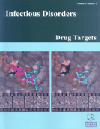- Home
- A-Z Publications
- Infectious Disorders - Drug Targets (Formerly Current Drug Targets - Infectious Disorders)
- Previous Issues
- Volume 7, Issue 4, 2007
Infectious Disorders - Drug Targets (Formerly Current Drug Targets - Infectious Disorders) - Volume 7, Issue 4, 2007
Volume 7, Issue 4, 2007
-
-
Editorial [Hot Topic: Influenza Virus Pathogenesis and Drug Targets (Guest Editor: Christopher F. Basler)]
More LessWhile seasonal influenza, caused by influenza A viruses and influenza B viruses, continues to cause significant morbidity and mortality, pandemic influenza raises fears of a potentially catastrophic public health event. Two occurrences in particular have galvanized support for influenza virus research, particularly as it pertains to pandemics. The first was the identification of human cases, and particularly those resulting in hum Read More
-
-
-
Influenza Viruses: Basic Biology and Potential Drug Targets
More LessInfluenza A and influenza B viruses are continuing causes of morbidity and mortality on an annual basis. Influenza A viruses have historically caused periodic pandemics in the human population, sometimes with devastating consequences, such as in 1918. Fears of a new pandemic have increased in recent years because of continuing outbreaks of highly pathogenic H5N1 avian influenza viruses in birds with occasional, but often let Read More
-
-
-
Reconstruction of the 1918 Pandemic Influenza Virus: How Revealing the Molecular Secrets of the Virus Responsible for the Worst Pandemic in Recorded History Can Guide Our Response to Future Influenza Pandemics
More LessAuthors: Lucy A. Perrone and Terrence M. TumpeyThere is an ever-present threat that a pandemic will result from the emergence of a new influenza strain to which humans have little immunity. In 1957 and 1968, new influenza viruses emerged into the human population and spread globally. Those pandemics were associated with high rates of illness and mortality, but both paled in comparison with the influenza pandemic of 1918. Reconstruction of the 1918 pandemic virus and Read More
-
-
-
Pandemic Influenza: Preventing the Emergence of Novel Strains and Countermeasures to Ameliorate its Effects
More LessAuthors: Solorzano A., Song H., Hickman D. and Perez D. R.Influenza is a seasonal disease that peaks every year in the winter months. Antigenic drift of the viral surface proteins, particularly the hemagglutinin (HA), is responsible for the virus's ability to evading the host's immune system, and for the severity of the disease. Pandemic influenza arises when an influenza virus carrying a novel HA gene enters into the naive human population, resulting in excess morbidity Read More
-
-
-
Influenza Virus Transmission: Basic Science and Implications for the Use of Antiviral Drugs During a Pandemic
More LessAuthors: Peter Palese and Anice C. LowenRecent and ongoing zoonotic infections of humans with avian influenza viruses have highlighted the importance of transmission in the development of an influenza pandemic. Despite the ability of H5N1 influenza viruses to grow to high titers and cause severe disease in human hosts, these viruses do not spread efficiently from human-to-human. The question of what viral, host and environmental factors are required to rend Read More
-
-
-
Influenza Virus Hemagglutinin - Structural Studies and their Implications for the Development of Therapeutic Approaches
More LessAuthors: James Stevens and Ruben O. DonisPossible adaptation of one of the currently circulating strains of highly pathogenic H5N1 avian influenza A virus to produce the next human influenza pandemic is an area of major global concern. Intense research is being focused on developing new generations of effective vaccines and antivirals. Here, we discuss the structure of hemagglutinin and its potential as a target for development of future therapeutics to mitigat Read More
-
-
-
The Influenza Virus NS1 Protein: Inhibitor of Innate and Adaptive Immunity
More LessThe influenza virus NS1 protein has been shown to be a multifunctional immune modulator and a virulence factor for this virus. Among its multiple functions are the inhibition of the type I interferon (IFN) system in infected cells, the binding and sequestration of dsRNA, the interference with the host mRNA processing, the facilitation of preferential viral mRNA translation, and the inhibition of dendritic cell (DC) activation. The com Read More
-
Volumes & issues
-
Volume 25 (2025)
-
Volume 24 (2024)
-
Volume 23 (2023)
-
Volume 22 (2022)
-
Volume 21 (2021)
-
Volume 20 (2020)
-
Volume 19 (2019)
-
Volume 18 (2018)
-
Volume 17 (2017)
-
Volume 16 (2016)
-
Volume 15 (2015)
-
Volume 14 (2014)
-
Volume 13 (2013)
-
Volume 12 (2012)
-
Volume 11 (2011)
-
Volume 10 (2010)
-
Volume 9 (2009)
-
Volume 8 (2008)
-
Volume 7 (2007)
-
Volume 6 (2006)
Most Read This Month
Article
content/journals/iddt
Journal
10
5
false
en


